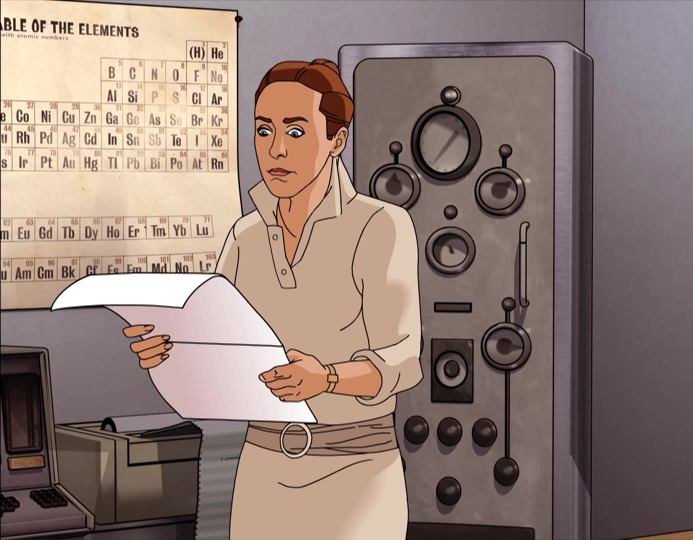
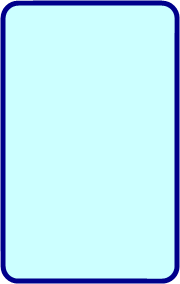
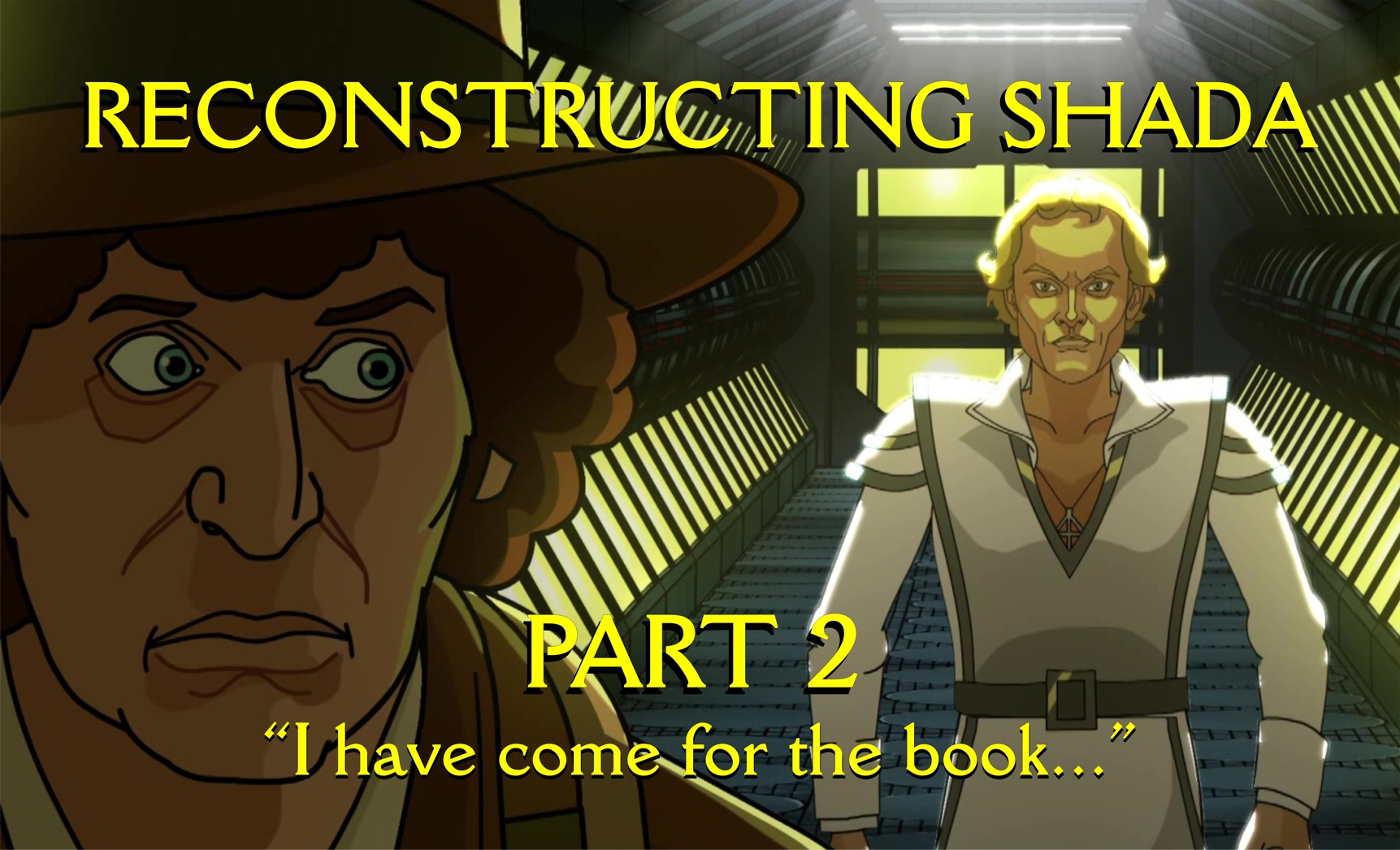
• CHARLES NORTON:
There's a few minor technical issues with the grading and rendering of this shot, which I won't get into, as nobody seemed to comment at the time. However, by the time you read this, I'm hoping the issues will have been fixed for the story's 2021 Season 17 Collection Blu-ray re-release (being worked upon at the time I write this).
What is worth commenting on however, is the attention to detail that artist Colin Howard once again managed to pack into his background paintings for this scene. You can't really make them out all that clearly in the final edit, but take a look at the books on Chris' shelf. When Colin painted the background, he went to the trouble of giving each book a title on its spine. The books are (from left to right): 'Vogon Poetry - Volume I', 'Vogon Poetry - Volume II', 'Vogon Poetry - Volume III', 'Where God Went Wrong', 'Some More of God's Greatest Mistakes', 'Who is this God Person Anyway?', 'Physics Paranoia' by Dr. M.P. Android, 'Physics is Fun' by Prof. H. Porteous, 'Computing Solutions' by E. McGrath and 'Victorian Theatre Tales' by H.G. Jago. The books on their side at the end of the shelf are: 'Digital Scribbles' by Colin Howard, 'Hyperspace Bypass Planning Law', 'Milliways - A Gourmet Guide' and 'Zaphod - My Stories'. The book on its side on top of the other books is: 'Minimum Safe Distance - Disaster Area'. On the lab bench itself, there's also a facsimile of the first edition of 'The Hitchhiker's Guide to the Galaxy'. That's the blue book near the corner.
Adams' original 1979 rehearsal script for Shada (written before Daniel Hill was cast as Chris) describes Chris Parsons as "about thirty... likes Bach, Bruckner and Status Quo." On these grounds, we put a record player on Chris' lab bench. You see it at about 12 minutes in, during this first lab scene. I was thinking about having some Bach, Bruckner and Status Quo LPs on the bench too. However, it was starting to look crowded, so we left them out in the end. Besides, it's quite obvious that Chris Parsons is far more of a 10CC fan.

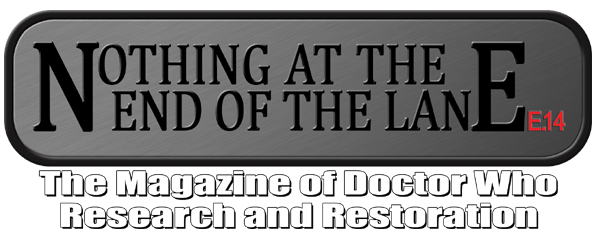
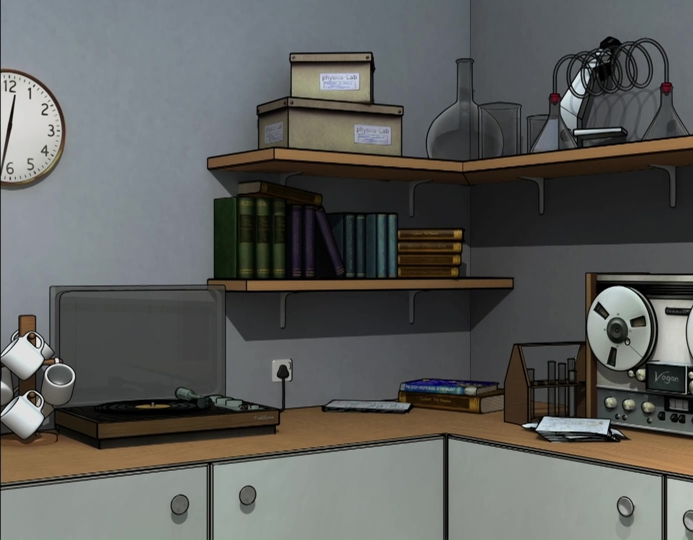
Yes, Chris has two copies of 'Zaphod - My Stories' and 'Hyperspace Bypass Planning Law'. We just duplicated the books from the shelf in the background and hoped nobody would notice, that the foreground books were in fact the same. And, you didn't notice, did you? Not until I pointed it out just then.
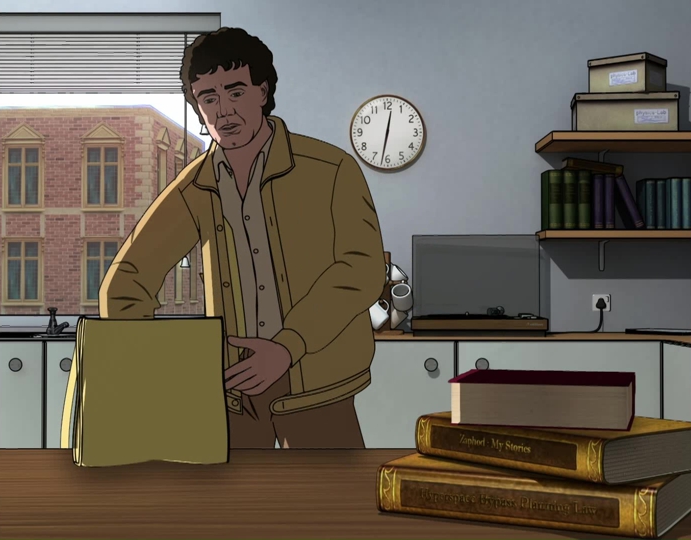
• CHARLES NORTON:
I might be misremembering, but I'm 90% sure that this was one of the first two shots of character animation to be completed for Shada. It was certainly scheduled to be completed first. Work on this shot started on June 12th 2017 although, at the time, there was still a lot of audio that the actors were yet to record for the animation scenes. That's the reason why this scene was animated first. There's no dialogue in it, so it could animated ahead of the actors recording their lines. Chris was largely animated by Joanna Hepworth for this scene. Joanna had also worked with us on the animation for The Power of the Daleks the year before and she would work with us again, as one of the character animators on The Macra Terror.
After Joanna had completed the first pass of character animation, all the shading on Chris' face and body were animated traditionally (one frame at a time) by Adrian Salmon and his assistant Alan Craddock. This traditional shading is one of the things that marks Shada (and The Macra Terror) apart from most of the other Doctor Who animations that we did. The shadows in Shada actually move with and around the characters, rather than just being cast onto the environment around them. Compare a scene of Chris in his lab in Shada with a scene of a character in the lab in The Power of the Daleks and you'll see the difference.
Animating the shading over the characters like this is essentially the same technique they used to give depth to the animated characters in Who Framed Roger Rabbit and it looks wonderful. Unfortunately however, it is also eye-wateringly time-consuming - really quite amazingly tedious and laborious work. A single second of animation can take many days of labour hunched over a drawing board or graphics tablet. We consequently had to be rather selective with the shots that we hand-shaded like this. We largely did it on quite brightly-lit scenes, which would otherwise have looked very flat without some degree of directional lighting. Other scenes, where there were more interesting lighting opportunities presented by the environment itself, allowed us to cheat a little more - such as on the Krarg carrier, where there was a lot of shadow and red colour casts to play with. However, in the board daylight of these Cambridge scenes, there was really nowhere to hide. We just had to go in and do the work frame-by-frame. The three people working on it most of all were Adrian Salmon, David Busch and Alan Craddock and they all really worked themselves into the ground on this. Tremendous dedication and attention to detail. Adrian explains the process...
• ADRIAN SALMON:
Before the actual animation colouring begins, a colour guide must be created for each of the characters. This is used to keep them consistent throughout the production. Plenty of research photographs were gathered first of the actors, from the original production itself where possible and also from any contemporary colour television shows they might of worked on. The aim is to create a palette for each actor. Their skin, hair and eye colour are the most important, as well the costumes they’re wearing. Once the colour scheme WIP is approved by the director, it’s then colour-coded for the animators, using the RGB Hex coding system. This usually includes both the desired base colour and darker/lighter values.
For the scene of Chris in the lab, a background colour layer was first established using the colour guide I created for Chris (front and side views). A new layer was then added above, set to ‘darken mode’ for the shading. I shaded a series of key frames for my assistant Alan Craddock to work from, showing how the shading would change as the character moved, including directional arrows to indicate the light source. He would then colour the in-between frames and return them to me for approval. Some shots could number up to 800 or more frames, each needing shading by hand which is time intensive. Before sending the final PNG sequence to Charles, I ran it through Adobe Bridge’s ‘Filmstrip’, which can be used to speed through a number of frames like a basic film projector. Inconsistencies would be flagged up and amended before shipping off and moving onto the next shot.
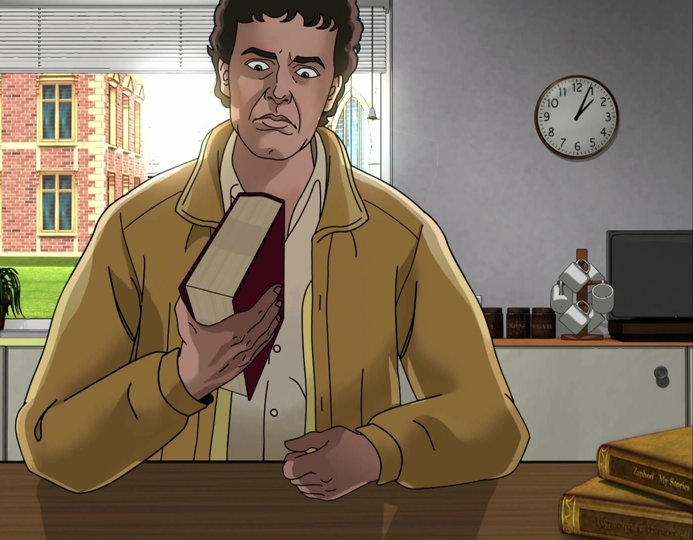


• MARK AYRES:
A totally unrelated aside, but much of the effects animation on Who Framed Roger Rabbit (seeing as Charles mentioned it) was done my old friend Kevin Davies. Who also worked on the TV version of The Hitchhikers Guide to the Galaxy.
None of that business with the clock or the self-aware book was in Douglas Adams' original script. In fact, none of this scene was really. The whole thing is just an exercise in trying to find visually interesting ways to suggest the book is a bit odd, whilst also helping to introduce something of the personality of Chris himself. In fact almost none of the animation up to this point bears any direct resemblance to anything in any of the 1979 scripts for Shada.
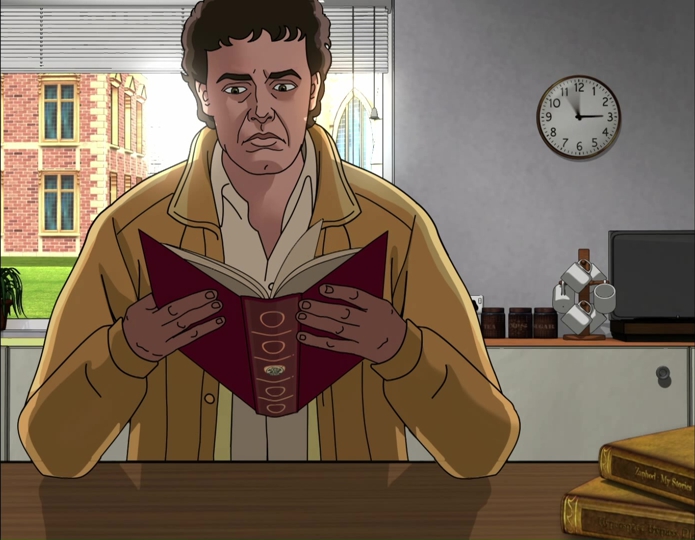
The original camera negative for this shot was another one that we were sadly unable to locate (the second of the three missing chunks, I spoke of earlier). When we had the negatives scanned, this shot simply wasn't there. What appears to have happened here is that when they removed the punting footage from the Shada negatives to splice into the negatives for The Five Doctors in 1983, they also (accidentally?) removed the very next shot on the reel - just a bit of excess on the end of the film. The next shot on the reel after the punting footage would have been this shot of the Doctor and Romana on the street outside the college. When the footage was cut into The Five Doctors, this extra shot wasn't needed and so just got snipped off. We assumed that it was then just thrown in the bin. Happily, prints were made of all the Shada film sequences back in 1979, before production was cancelled. So, although we didn't have the original camera negative for this shot anymore, we did still have a print, taken from the negative prior to its molestation. The relevant section of the print was thus called up and we scanned it in, along with the other footage, to patch up the gap. And that's what you saw when the story was released in 2017 and broadcast in 2018. The final shot is a little grainier (coming from a print) than the surrounding footage. However, at least it was there.
A quick sidenote here. As I say, back in 2017, we were left to assume that the negatives for this shot had simply been chucked in the bin in 1983. It was just a loose bit of film that they had no use for. Our natural assumption was that it had just been swept up with the film trims at the end of the day. However, it turns out that our assumption was wrong here. A few years after we completed Shada, Peter Crocker was going through the film negatives from The Five Doctors and he stumbled across a tiny bit of film on one of the rolls that really shouldn't have been there. It was our missing Shada shot. It turns out that when The Five Doctors was edited in 1983, they didn't throw this off-cut of film away at all. They simply spliced it onto another roll and then forgot all about it. When Peter began work on the remastering of Shada for its box-set re-issue in 2021, he was thus able to re-instate this missing shot. And so, if you're watching Shada on the 2021 Season 17 Collection box-set, you might just notice that this one shot now looks a little bit crisper than it did back in 2017.
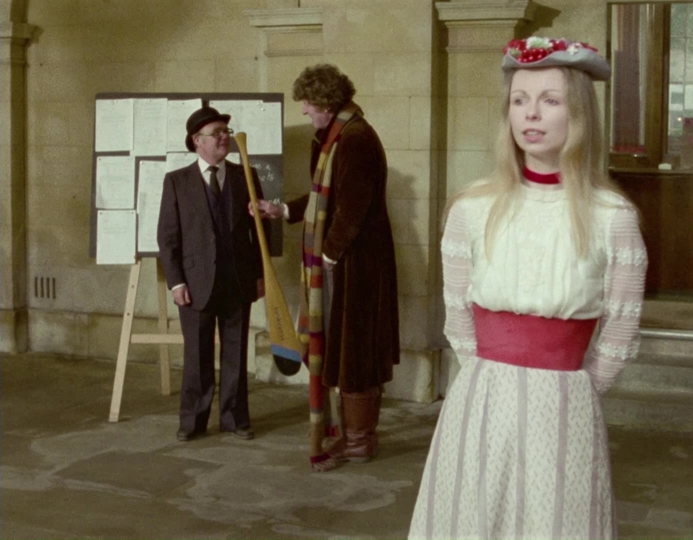
In 2018, Shada was broadcast on BBC America, the first and (to date) only time that the story has ever been broadcast on television anywhere in the world. As BBC America is a commercial broadcaster, that meant ad-breaks. The first was inserted just after the Doctor makes his joke about being crackers. BBC America cut to a commercial break at the end of that shot. In total there were twelve ad-breaks during the TV broadcast of Shada - roughly spaced about ten minutes apart. We created a special commercial broadcast master of the story for this very reason, with fades-to-black at each ad-break marker to allow BBC America to insert their idents and commercials upon transmission.
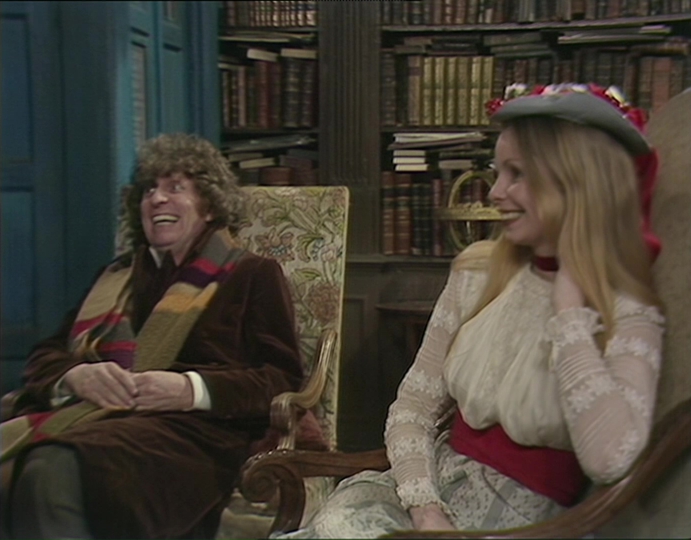
The original rehearsal script for Shada had a scene at this point in which Chris tries to cut the book with a razor blade. However, we'd already inserted so many new bits of action into our lab scenes (with scalpels and magical clocks) that we'd essentially covered everything that needed to be shown with regards to Chris' interactions with the book by this point. And so I decided to omit the scene with the razor blade. It would only have felt repetitious otherwise.
As the scene is not among those that were shot in 1979, I suppose it's even possible that Pennant Roberts might have come to the same conclusion as we did and may have ended up leaving this scene out of his edit too. We'll never know really as Pennant sadly isn’t around anymore for us to ask him. It's certainly clear that he shot more material than he would ever have actually included in his final edit. We know that much. But which bits he'd have left in and which bits he'd have left out, is anyone's guess. I certainly had no qualms about sometimes skipping scenes, however. As I know that it is exactly what the original production team would have done in 1979. Even what they did shoot is sometimes very different to what's in the original script. Small changes are made all the time during the production process. Things that are in the original script end up not being shot. And things that do end up being shot may never have been in the original script at all. It was happening throughout the 1979 production block and it happened throughout the 2017 production block too.
After all we weren't making a reconstruction here. This was a completion, not a restoration. And we were approaching it just as the original crew would have done - as a new work in its own right. Making our own creative decisions along the way about how best to make the production work.
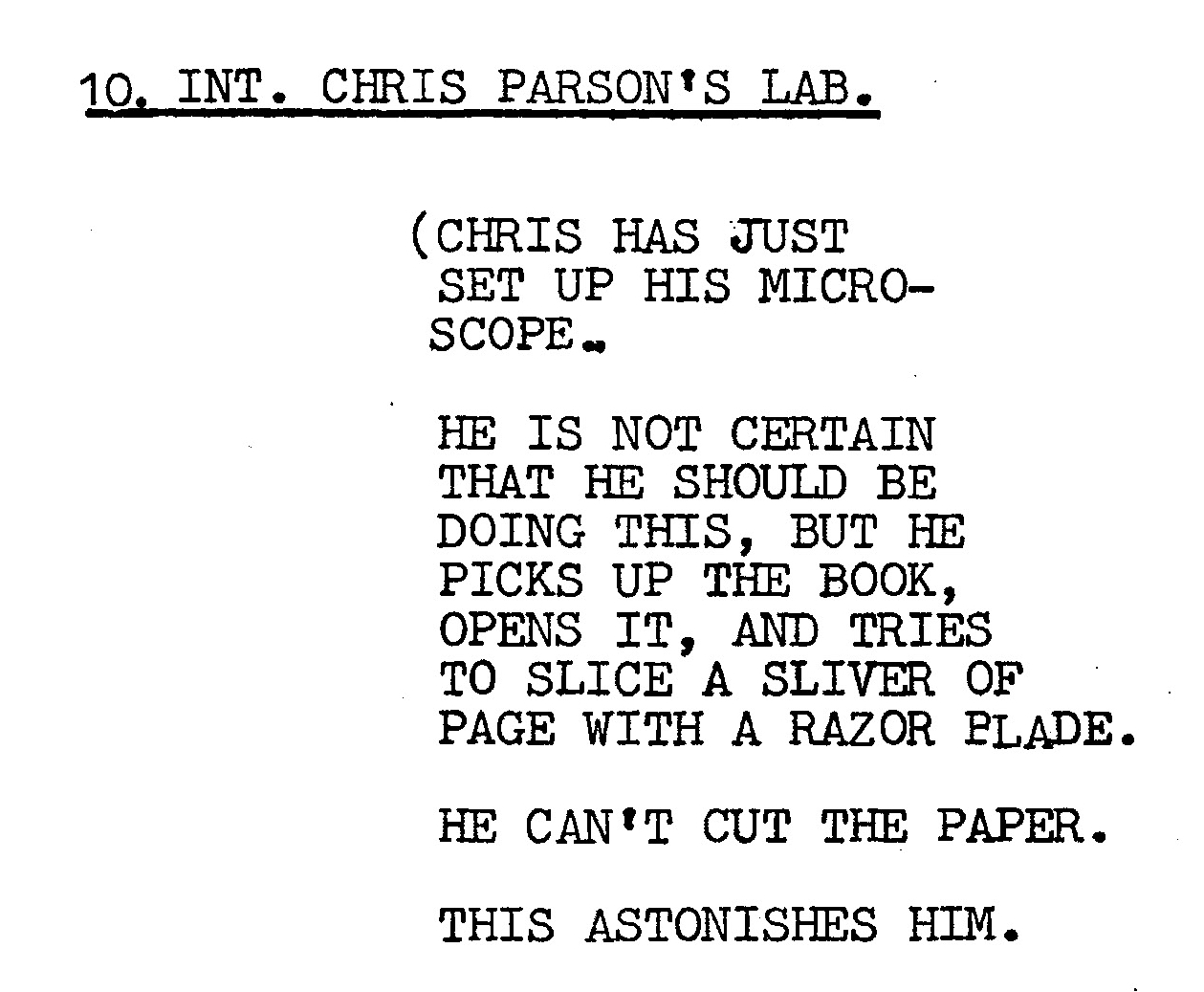
Shaun Askew and Ana Garcia Sebastia did the bulk of the character animation on this scene. The character shading was again animated by Adrian and Alan. Work began on the animation for this shot on June 19th, once again, largely while we were still recording dialogue with the actors. The little cry of pain you hear from Chris was actually recorded a few days after the first pass of animation was completed. It was dropped in during the dub. A rare example of animating a scene first, ahead of recording the actors who appear in that scene.
Incidentally I know, XRT machines don't look quite like that in real life. I did notice at the time. However, I liked Colin Howard's design anyway. The original script actually has the book in a conventional X-Ray scanner. However, I'd just concluded some work with the X-Ray microtomography team at Queen Mary University in London and decided it would actually make more sense to have the book scanned that way. It is difficult to see what meaningful data Chris could ever have expected to get from a conventional flat X-Ray. XRT would have been a far more obvious thing to do. I checked to make sure such scanners would have existed in 1979 and they did. The earliest UK machines started to appear around 1971 and it's completely plausible that Cambridge University would have had access to such equipment in 1979, especially for post-graduate physics.
• MARK AYRES:
I couldn’t find a sound effect of a microtomography machine so I think I used a slowed recording of a microwave oven. I should have asked Charles to ask his friends at Queen Mary University to record theirs.
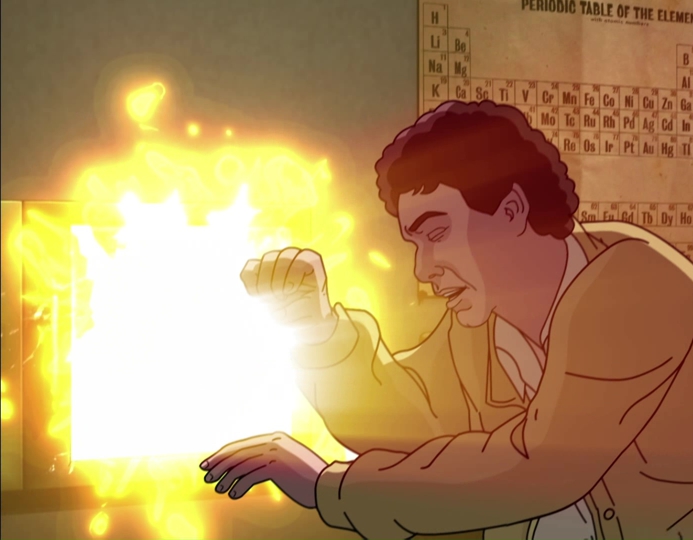
If you're watching the 2021 remastered version of Shada (released as part of the Season 17 Collection and as a solo release in Germany), then you'll not see anything wrong with this shot. It will look absolutely fine.
However, if you're watching the 2017 DVD or Blu-ray release, take a look at the top left of the screen after Chris walks away. You see that little white square with pencil marks on it? That's the storyboard. When the compositing was being done for this shot, Rob Ritchie had a little minimised image of the relevant storyboard panel for each shot inset at the top of the screen. So, whichever shot he was working on, he could see what the final comp was designed to look like. When the final shot was rendered out, this storyboard panel would (normally) be deleted. However, in this one case, it wasn't. And when I checked the scene for approval, I failed to notice that the storyboard panel was still embedded in the corner of the shot.
Years went by and it was only when I reviewed this footage for the 2021 Blu-ray remaster that I finally spotted the error. And we've now fixed it for the new edition. So hopefully you'll not have to worry about it again.
In our defence, Shada has been out on DVD now for nearly five years and I'm not aware of any viewer ever having noticed this error either. Although, to be fair to BBC America viewers, they never even had a chance to notice it. This entire scene was cut from the BBC America broadcast in 2018, in order to bring the runtime down and allow more time for scheduled commercial breaks. One of a handful of trims made for that transmission.
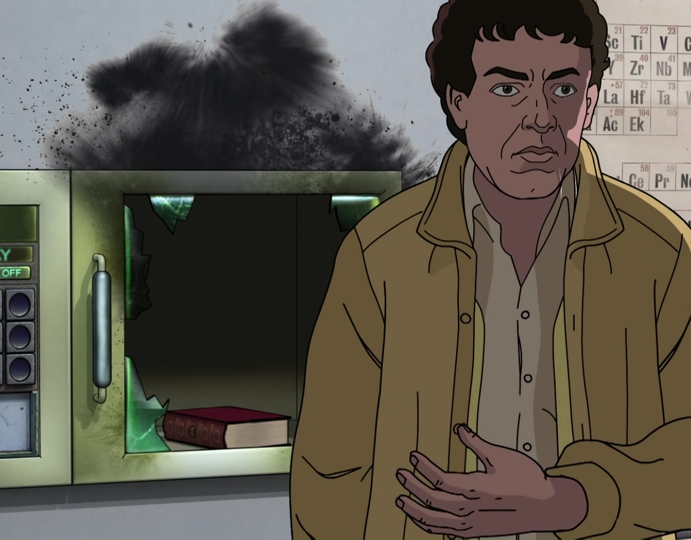
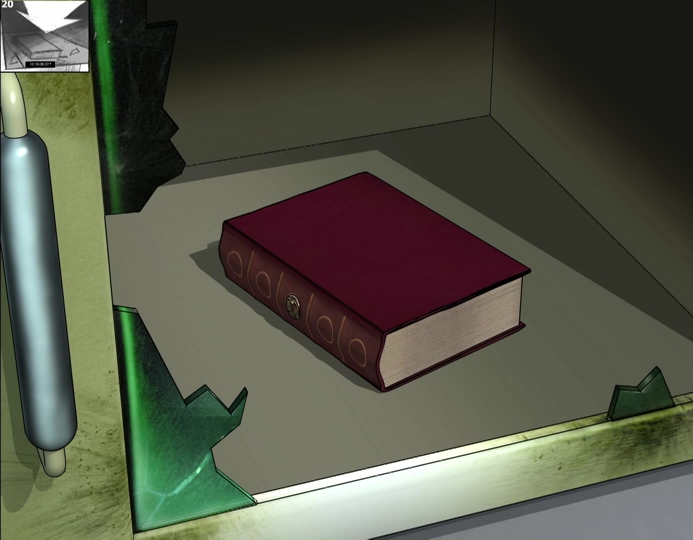

Our first bit of animated dialogue. All the static background elements (including the phone box) were painted by Colin Howard. However, the blue car you see driving past in the background was done by Martin Geraghty. The car is (of course) a Ford Prefect.
The character animation on this scene was completed (in mid July 2017) by AnneMarie Walsh, who was our animation lead on this production. She had earlier worked with us on The Power of the Daleks and has subsequently directed The Faceless Ones. AnneMarie was invaluable on Shada, supervising (and doing most of the rigging) for all the characters kits. She also helped oversee the entire team of character animators, as well as animating many scenes (like this one) herself.
• ANNEMARIE WALSH (Animation Lead):
(Quoted from the 2017 DVD audio commentary): I started in June. Martin [Geraghty] would have started before me, designing the characters. In June, I started drawing up some of Martin's designs into what we call character-kits. And then the animators... started three days later... We used a lot of the original footage as reference, to understand what the actors were bringing to the roles and through reading the script and through the director's notes tried to imbue the still drawings with a real sense of what the actors were about and what Douglas Adams was trying to get across.
I worked quite closely with Martin, who designed the characters in pencil and we did explore a number of different line-strengths and approaches, trying to balance nice artwork with the time we had in which to produce all of this. We went with a pretty flat line in the end. We had three or four days where we had a lot of back and forth between us, with Charles and Adrian Salmon. And once we had a design that we felt was a fair compromise between the look that we wanted and the time we'd have to produce it in, I started drawing up the kits in [Adobe] Flash with a Cintiq, which is a big digital drawing board.
• CHARLES NORTON:
The audio for this scene was done on our second day of dialogue recording on 26th June 2017. Tom Baker wasn't there for that day, but the rest of the cast were. We recorded at Motivation Sound Studios in London (a former Disney sound studio, in operation since the 1940s). Martin Geraghty and AnneMarie both attended to make notes and sketches of the actors performing, which would help inform how the characters were later animated.
• MARTIN GERAGHTY (Character Art):
I travelled down to London for the day with AnneMarie to attend the recording of the remaining cast reprising their roles. Essentially this was to make notes of how the actors ‘performed’ their parts so I could use the action in the animation. Christopher Neame came up trumps in this dept, and his silkily evil reading gave me some real details, the clawed hands rising up as he outlines his plans for universal domination being a key motif.
Daniel Hill was also a joy to meet, discussing regional accents with me before his stint in the booth. Chris is a fairly passive character in the story but his comedic bewilderment was very well-conveyed in his reading. Obviously all of Lalla’s Romana exists so her reading were primarily a chance to watch her recreate a role I’d watched on telly almost 40 years previously.
• ANNEMARIE WALSH (Animation Lead):
(Quoted from the 2017 DVD audio commentary): Skagra, especially in the early scenes (where he's in control and in power) is still a lot of the time - which is quite a powerful pose. From an animation point of view, it was really interesting seeing the actors play the characters. Christopher Neame in particular used his hands a lot, while being very conscious of where the mic is. He wasn't moving around much. It was a very contained performance. Subtle, but a very expressive performance. It was really fascinating to watch. How much he managed to get out of very subtle, small gestures and movements. So we tried to bring that into the animation of the character as well.
• CHARLES NORTON:
In order to get exactly the right acoustics for the audio, we used the same kind of microphone that would have been used in 1979 in the studios at TV Centre. We brought in Michael McCarthy as our sound supervisor. Michael was a key member of the BBC's sound crew throughout the 1970s. He worked on The Goodies, Steptoe and Son, The Morecambe and Wise Show, Dad's Army, The Good Life and... well, an awful lot else besides. He also worked on the studio sound for three Doctor Who stories: Terror of the Zygons (1975), The Invisible Enemy (1977) and The Sun Makers (1977). He didn't work on the original Shada shoot in 1979, the sound supervisor on that was Michael's late colleague John Hartshorn. However, Michael did work with Douglas Adams a little after that on the 1981 TV production of The Hitchhiker's Guide to the Galaxy.
Michael was able to source exactly the same kind of microphone boom shock mount that John Hartshorn had used for the Shada studio scenes in 1979. Michael was able to identify the exact model by studying a production photo taken during the original studio recording. Hartshorn had used an AKG C414 microphone inside in an experimental Fisher Boom mount. The distinctively warm audio characteristics of the completed 1979 footage also confirms this. Happily Michael already had an AKG C414 among his own kit and we were able to hire the shock mount in specially.
• MARK AYRES:
I was very keen to get Michael involved, as I knew that getting the sound right in studio would help enormously when it came to me trying to make it all sound cohesive in the mix.
• CHARLES NORTON:
For the scene of Chris on the phone, we changed the scripted location. The scene was originally written to take place in the lab. Shifting things to the phone box outside seemed more visually interesting though, so we tweaked things accordingly. To make sure this made some kind of logical sense, we intentionally did not include a telephone among the set-dressing in the lab, giving him a reason to nip outside and make the call.
I also slightly redrafted the scripted dialogue in this scene. The version of the scene as scripted in the original rehearsal script was radically different to the version of the scene as scripted in the later camera script. However, I quite liked elements of both different versions. I thus created a composite, combining some of the dialogue from one with some of the dialogue from the other. This happened with a couple of other scenes too. Although, most of the time, we largely worked from the rehearsal script, which would probably have been closer to Douglas Adams' original intent.
When we recorded the audio for the phone box scene, we had Daniel in the corner of the studio, with his back to us, to try and get the right kind of enclosed acoustics you'd have had in a phone box. It wasn't quite working on the first take. So, on the second take, Daniel took out his mobile phone and did the whole scene talking into that (with the microphone suspended above him). This seemed to work much better.
Incidentally, this entire scene was cut from the BBC America transmission. Quite a bit of the early part of the story was never included in the broadcast version of Shada. Again, it was all done to allow BBC America more space to insert television commercials across the production's feature-length run-time.
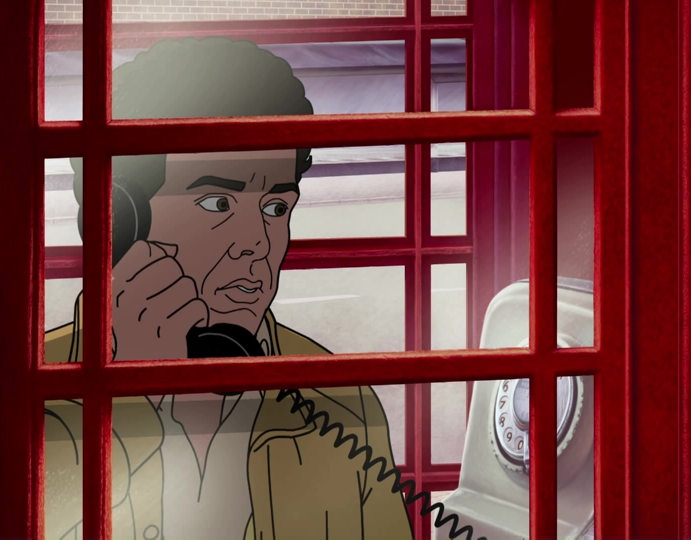
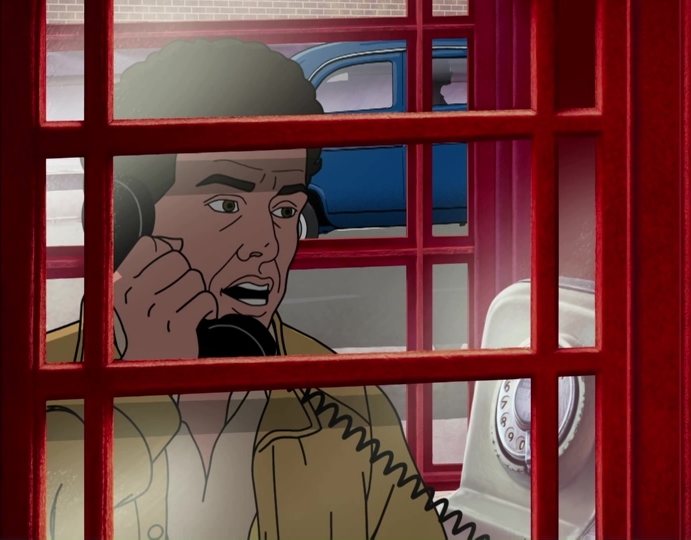
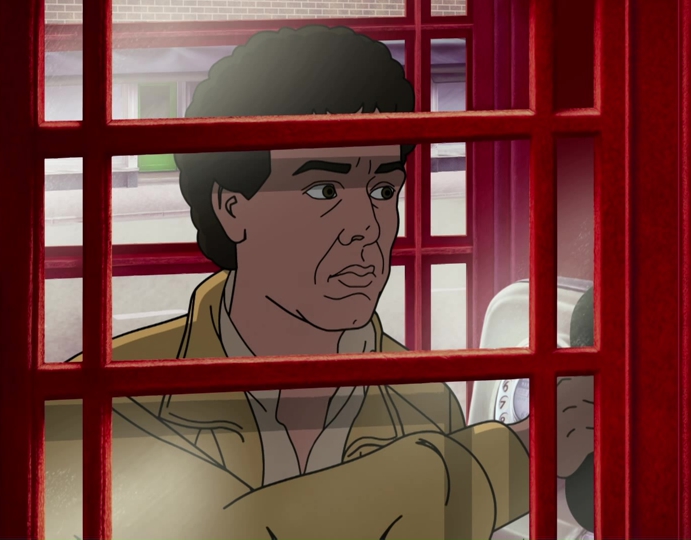
This is another scene that was cut from the 2018 BBC America transmission. Although, as with all these trims, it was on the DVD release.
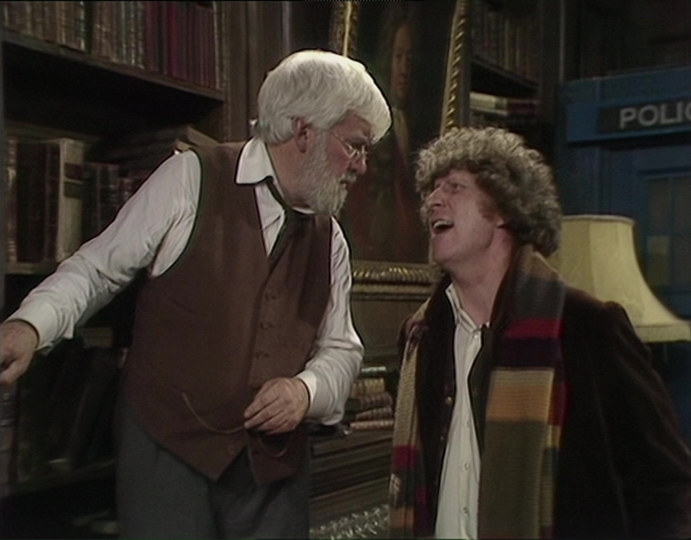
Some more missing film negatives here. Or at least, they were missing for a while. The shot of Skagra walking through the air was shot at Ealing Film Studios on 22nd October 1979. A number of other similar blue-screen shots were also done that day, all shot on 35mm colour film. However, when we called up all the camera negatives for Shada in 2017, none of the 35mm Ealing stuff was there in any form. It was all missing. What's worse, there were no prints of the footage either. In fact, the only source we had for any of the Ealing material was a very ropey standard definition videotape transfer made of a (since lost) print back in 1992.
After much digging we eventually located the lost footage. It was in private hands. A BBC archive employee had managed to rescue it from destruction back in the 1990s and had held onto it. It seems likely that it had been withdrawn from the archive during the production of BBC Video's Shada compilation tape back in 1992 and never properly returned. The person who now has the footage had tried on a number of occasions to return it to the BBC archive, but had been told the footage was no longer wanted. So, he held onto it. And still continues to do so. He was happy for us to borrow it for our production and we had all the material scanned in 2K, as part of our main film ingest session at R3Store in June 2017.
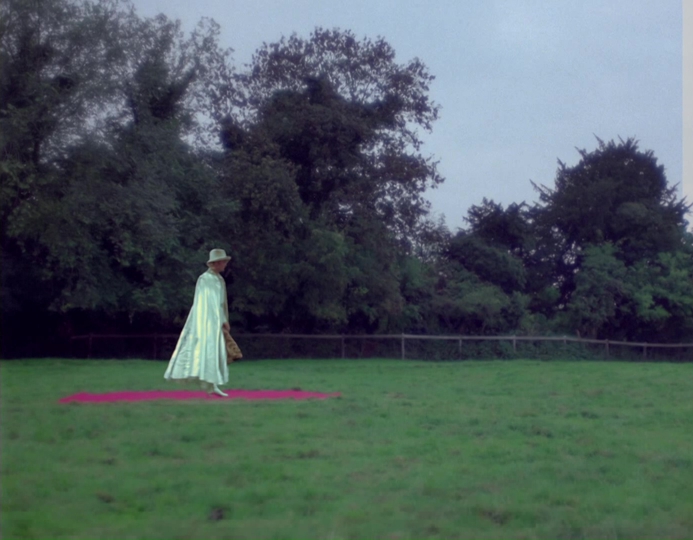
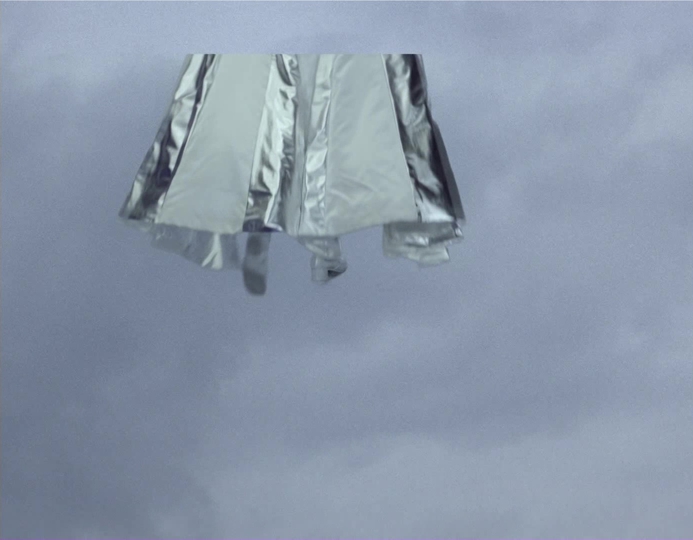
The original production team's final four-part script for Shada has another odd cut marked down at this point. It seems that it was their intention to cut everything from 25'16" through to 25'31" (timings taken from the 2017 edit). I have no idea how they were expecting to make this cut work. It happens in the middle of a shot and the characters move within that shot. The edit would have clearly resulted in Chronotis suddenly hopping from one part of the frame to another, without any explanation of how he did so.
This again perhaps indicates that the 1980 edit was only ever a rough-cut paper-edit, designed to be fine-tuned later in VT edit session that never ended up happening.
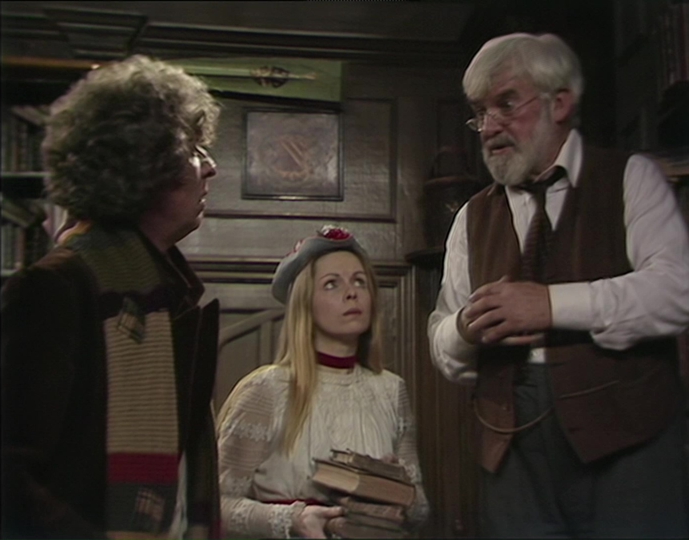
At 27'02", just after Skagra tells the universe to prepare itself, BBC America cut to their second commercial break. There is no camera script for this part of the story, so we can't be certain, however, it is also likely that this is (roughly) where Part 1 of Shada would have ended, had it been broadcast as a six-part serial back in 1979. However, as I say, we can't be entirely certain, because Pennant Roberts never got as far as drawing up any camera or editing plans for this scene. We don't know if he was even planning to shoot this scene at all, although I suspect he probably would have shot at least some version of it.
This scene was the first one Christopher Neame recorded for us on 26th June 2017. The last time he'd been in a BBC studio playing Skagra it was Bonfire Night 1979. So, quite a big gap between call-sheets.
• MARK AYRES:
For the 2021 six-part edit I added in a new shot of the Krarg on the monitor from the carrier ship, “What is your command, Master?” (line borrowed from later) to give us a cliff-hanger ending to Part 1. The original scripted line, which we did not have, was “Everything is ready, my Lord.”
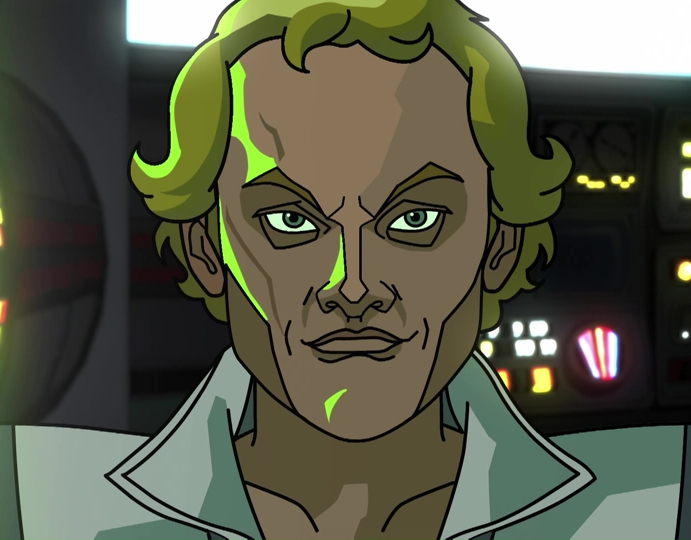
According to the notes on the 1980 four-part script for Shada, it was the production team's intention to cut almost all of the first half of this scene. In that version of the production, we would have joined the scene only after the Doctor and Romana have finished going through the book titles. They still shot the complete version of the scene back in 1979 of course (as you can see). They just later appear to have decided to cut it.
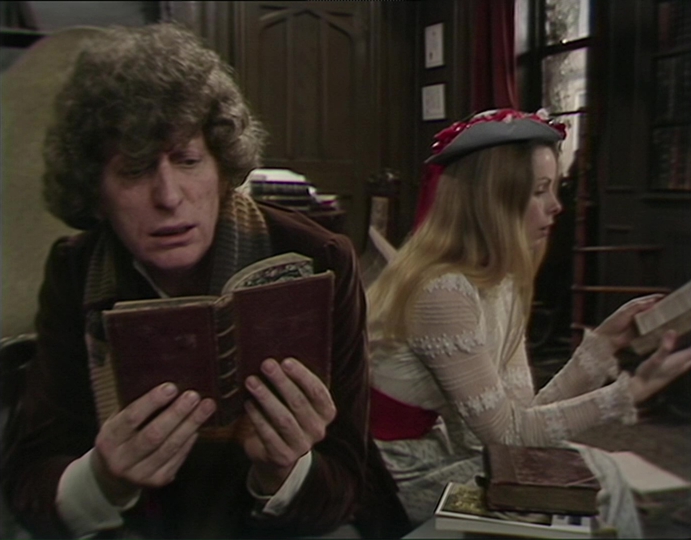
Clare was a character that we had to keep close very tabs on when plotting out shots. In the location scenes filmed in Cambridge in October 1979, Clare has her hair up in a bun. She also wears it like this in most of the studio scenes shot at Television Centre in November 1979. However, in some of the studios scenes, taking place toward the end of the story, she has her hair down. This was a rather nice bit of visual shorthand to underscore her character progression across the story. It makes some logical sense that Clare would take her hair down in the later scenes. She suddenly finds herself marooned in a strange alien space-ship, without any possible way of returning home. So, she has a cup of tea, sits down and unties her hair. I can see that being a pretty normal thing to do in the circumstances. However, it also helps to signal the change in her attitude across the story. Initially sceptical, contained and un-engaged in the narrative and later fighting giant rock monsters with a talking robot dog. It does sort of work on a dramatic level. Unfortunately, it makes it quite important to keep tabs on the continuity, when 38 years later we have to finish off the production. To help us with this, for every scene involving Clare, all my script pages and storyboard notes are very clearly marked at the top of each page. The early scenes are marked as 'Bun Clare' and the later scenes are marked as 'Bushy Clare'. Whenever an animator had to do a scene with the character, they had to check the notes on that shot that told them which one of Clare's two animation kits they were to use - Bun Clare or Bushy Clare. Of course, this in turn also meant that Martin and AnneMarie had to create two distinct character models for Clare as well.
The laws of unintended consequences really - where a nice little visual touch conceived of in the studio many decades ago, ended up having a profound effect on the workload of everyone involved further down the line. Still a nice idea. However, by the end of production, I'm sure we all wished that she'd just left the bloody stuff tied back throughout.
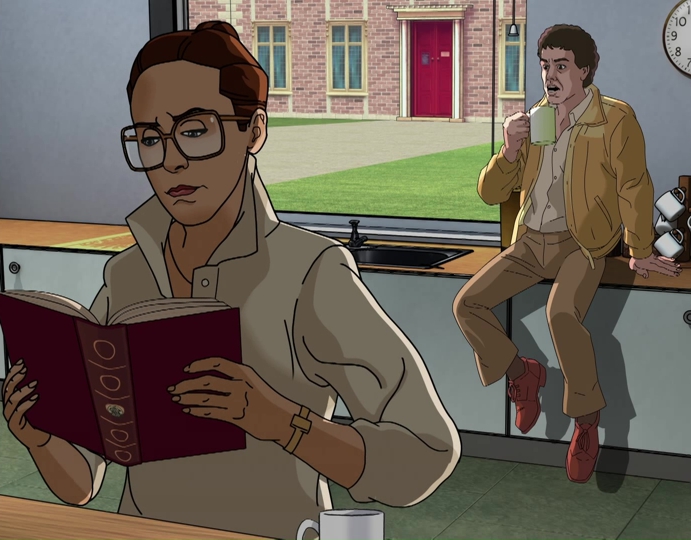
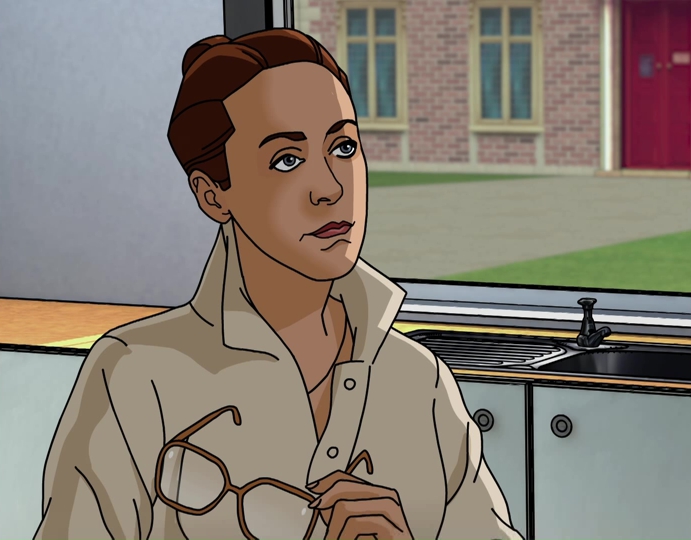
I can't tell you how long we spent on that smile as Chris leaves the room. It's meant to be a spontaneous and unchecked smile for a girl that Chris it yet to fully realise he's falling in love with. Sadly, I don't know that we really got that across at all. Perhaps I was being a bit over-ambitious with how much nuance I was expecting from these character kits.
The chief problem was that the characters hadn't really been designed to both speak and smile at the same time. They could do one or the other pretty well, but not the two together. Consequently, Martin had to re-draw all the mouth shapes for the scene, so that the smile didn't drop as Chris spoke. Animator Barry Evans (Barry was, and is, another long-time collaborator on these projects. I first brought him in to work on The Power of the Daleks in 2016 where we had him doing a quite stupidly astronomical amount of character animation - especially on Janley) then spent a fair few days tweaking it all in Adobe Animator. In the end, we never really got it entirely to work as intended. However, it certainly wasn't for want of trying, with both Barry and Martin putting an awful lot of work in here, for such a brief and fleeting moment. And the final shot, even if it's not perfect, is still a huge improvement on the first draft of the shot, in which Chris' smile was far less "I think I love you" and far more "I think, I'd like to stab you while you shower". Incidentally, after all those days of work, the whole of this scene with Chris and Clare ended up being absent from the edit that was broadcast by BBC America.
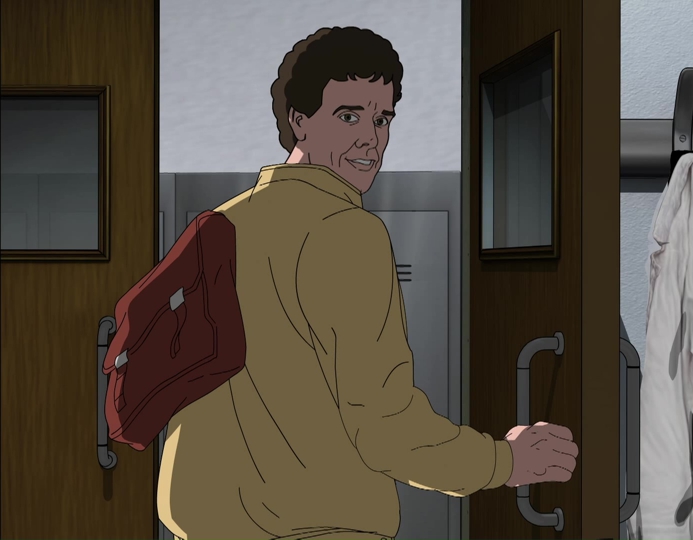
After we leave the scene with Romana at 31'49", it was originally scripted that there would then be another scene, that slotted in just prior to the location footage of Skagra leaving his ship. In this (very short) scene, Skagra asks his computer for its opinion of his new clothes. The computer says they are: "perfectly correct in every detail." And then Skagra leaves. We decided to cut this scene completely. Which is to say, we decided not to record it.
If we had included this scene, it would have meant cutting away from a very long block of live-action to a very short block of animation, before then cutting back again. This clearly would have broken the momentum of the narrative, for no good reason. We'd have had a massive slab of live action, followed by a single animated scene and another massive slab of live action. We did have to do this on occasion. However, it was something we tried to avoid or minimise wherever possible. Overly frequent intercutting between the two formats always ran the risk of pulling the viewer out of the story at a key point, breaking up the narrative flow. We tried (wherever we could) to consolidate material into either large chunks of live action or large chunks of animation, with only minimal chopping and changing between the two. This is also why we shot so much new live action material for Shada. There's not always a perfect solution, as consolidating scenes together into longer stretches, can sometimes slow the pace of the narrative overall. Intercutting between the scenes in shorter bursts certainly helps with that. However, then you're back to the original problem of making things feel disjointed. It's always a trade-off. There's a fine balance to be struck between the consistency of the production and the pacing of the narrative. Removing this scene also allowed us to save up the computer's first substantial line of dialogue for a later scene, giving that moment a bit more impact than it would have had here.
As with our other cuts, this editing was all done ahead of recording, of course. Almost none of our cut material was ever actually recorded. We had precious little time to record the audio we did want to use, without recording stuff we didn't.
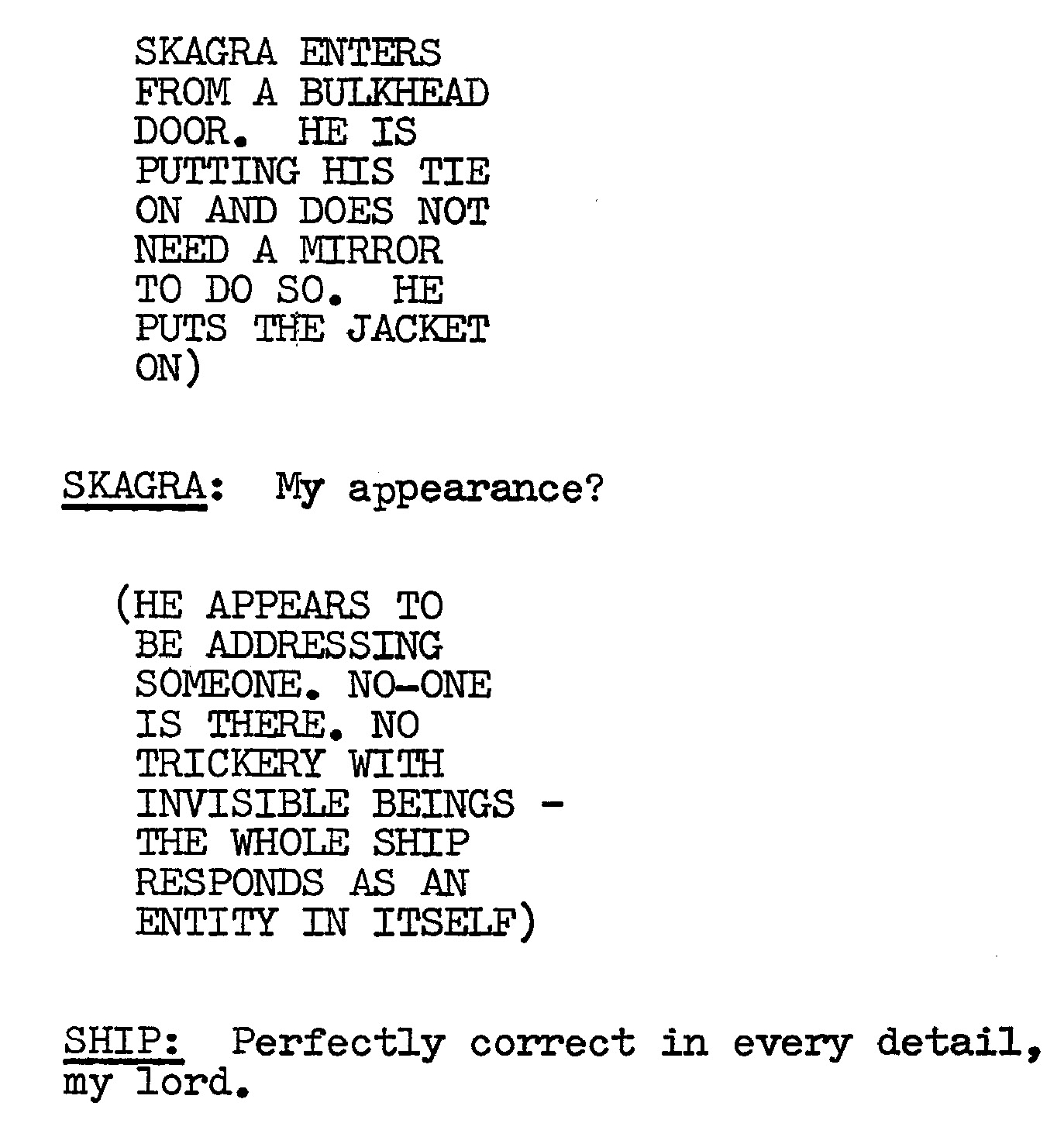
The four-part script for Shada (the one prepared for the aborted 1981 transmission) indicates that the production team intended to cut Chronotis' little speech about the kitchen being too far from the control chamber. Romana's reply to that line would also have ended up on the cutting room floor. The decision again seems odd, as the footage had been shot in such a way that would make this edit quite difficult to carry off.
• MARK AYRES:
Again, later editing was not in the team’s mind when Shada was shot. And it may well be that the impossibility of some of these cuts (assuming the material was later viewed to see if the paper edit was feasible in practice) contributed to the four-part idea being dropped.
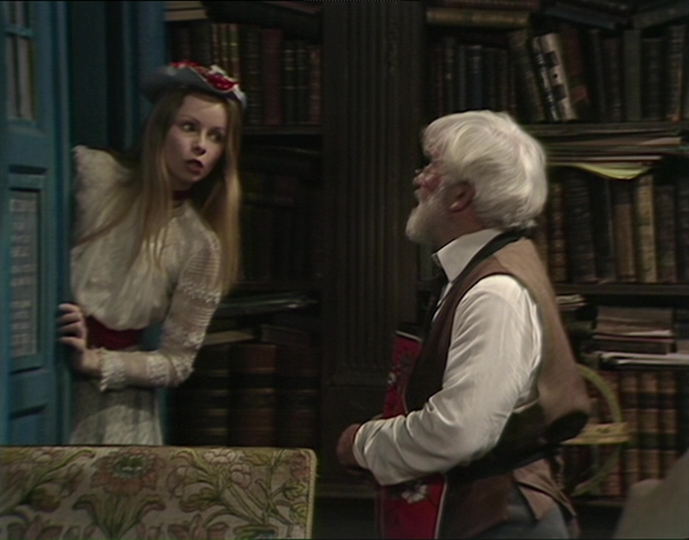
There's an 'invisible' shot change here, just as Chronotis leaves the frame. Very easy to spot when you know it's there but hopefully not that easy to spot if you're not actively looking for it. The reason for cutting in the middle of a shot? Well, we had two different takes of this scene. The first take was very good at the start, but less good toward the end. The second take was better at the end, but less good to begin with. By joining the two better halves together, you got the best overall. With nothing else available for us to cut to, this was the best place we could find to hide the edit. It's not ideal. However, it allowed us to get the best out of both actors' performances.
• MARK AYRES:
For the six-part edit, I stuck with the same take throughout.
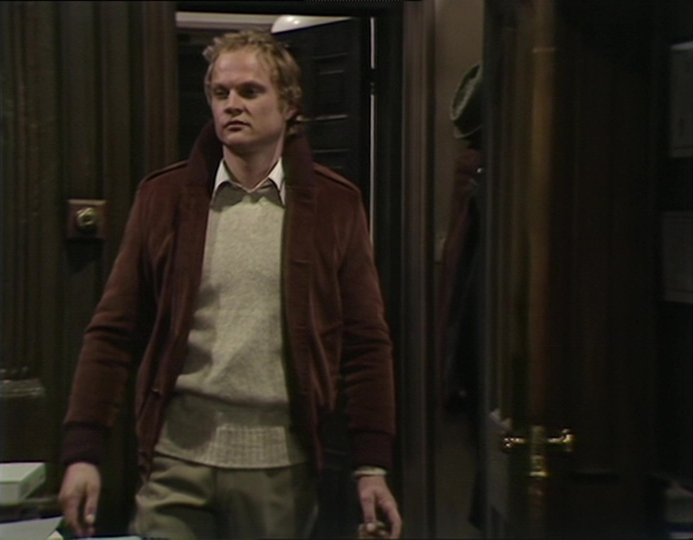
Yes, that was a continuity error. The professor's glasses keep appearing and disappearing between shots. Sadly, that's just down to how this scene was originally shot back in 1979. The scene was completed across two separate days and they clearly lost track of the continuity as they picked up the last few shots on the second day. It would have been nice to have digitally fixed it. However, the complexity of CGI required to do this was beyond our budget.
It was immediately following the end of this scene (at 36'00") that BBC America cut to their third commercial break. It is also the exact point where the original production team intended to end Part 1 of Shada, had it been completed as a four-part serial for broadcast in 1981. Of course, work was sadly abandoned on the four-part version of the story quite early on, so television viewers had to wait until 2018 to get this scene as a cliff-hanger.
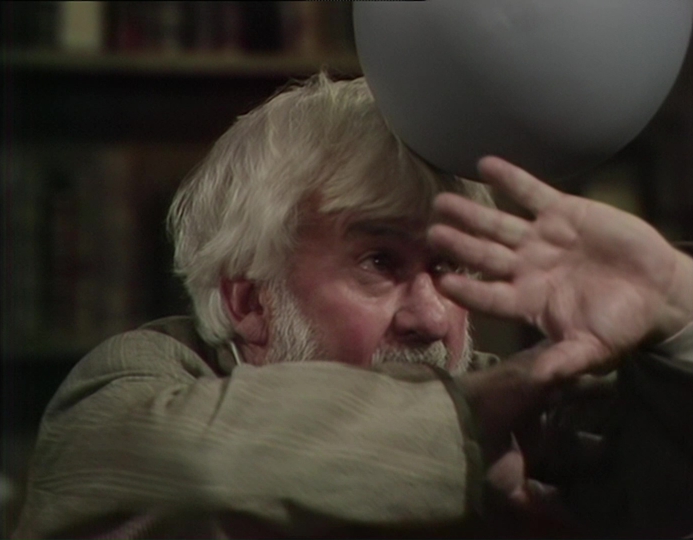
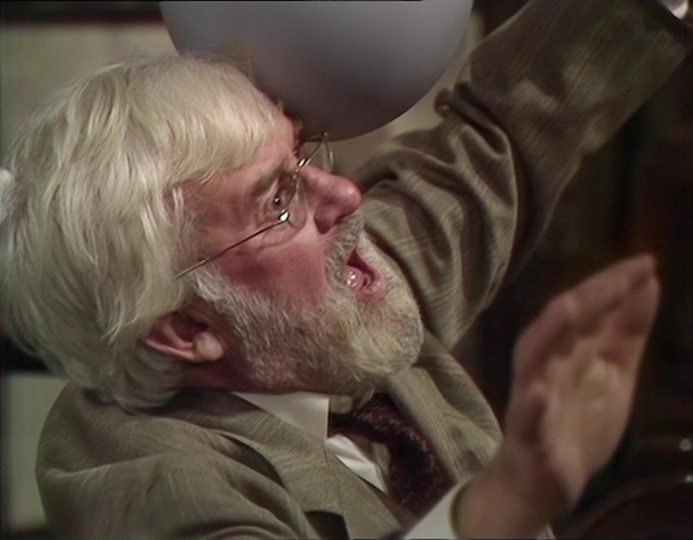
The original 1979 rehearsal script says that there should be a scene here (after Chronotis' 'death'), in which the Doctor approaches the lab. It is specified as a location scene, to be shot on film in Cambridge. However, we went through all the footage that was shot in Cambridge and this scene simply isn't there. It seems that it was either filmed and Pennant Roberts then decided to leave it on the cutting room floor or he simply decided never to film it in the first place. Probably the latter. Either way, it doesn't exist.
We could, I suppose, have made an animated version of the scene. However, the original production team had clearly decided that they didn't want this scene there and I decided to go along with that. So we left the scene out. Personally, I think it works better without it. It gives Tom's first animated appearance a bit more impact and it feels pacier cutting hard to the lab. The latter reason probably also being the motivation behind Pennant Roberts lopping it out back in 1979 perhaps.
• RICHARD BIGNELL:
The scene that Charles describes was due to be filmed outside Cavendish Laboratory off Madingley Road in Cambridge on Tuesday 16th October 1979. The plan for the day was for all the scenes at Grantchester Meadows to be filmed set around Skagra's invisible spaceship and the TARDIS as well as the sphere's attack on the fisherman. Once the ten sequences were completed, the crew would then move the four miles to the laboratory to film the single scene of the Doctor approaching on his bike and entering the building, planned to take place sometime between 5-6pm. However, it's likely that all the filming that needed to be accomplished at Grantchester Meadows simply took longer than planned and with the sun setting around 6pm that day, it wasn't deemed worthwhile moving the crew to a new location to accomplish a single additional shot.
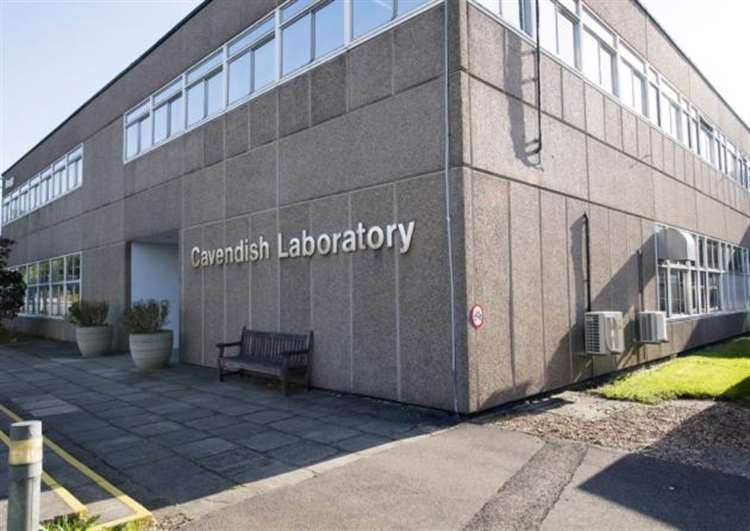
I really liked those daft glasses Clare has here. I felt they were another nice character touch. In the original 1979 footage, Clare only actually wears them in one scene. However, I decided to put them into some of the earlier animated scenes too, as they just gave us so many opportunities to do interesting things with them (as you see in this scene). They also sort of inform the character. Anyone who is going to walk around wearing glasses like that clearly has a level of self-confidence that is not entirely normal. This is not a shallow person. I should perhaps add here that I believe the glasses actually belonged to Victoria Burgoyne at the time. She just decided to wear them in the studio one day and the director liked the look of them. There's even a publicity photo of Tom Baker wearing them at one point.
This is the first of many scenes in Shada where we had to record different parts of the audio on different days - for scheduling reasons. So, Tom Baker's audio for this scene was recorded at Audio Sorcery Studios on 9th June 2017, with Toby Hadoke reading in Clare's lines (in order to give Tom something to act to). Victoria Burgoyne then came in to record her lines as Clare on 26th June 2017, at Motivation Sound Studios. I played in Tom's previously recorded audio into the studio off a laptop. We did three takes of Tom's part of the scene and two takes of Victoria's part of the scene. Parts of all five takes were then edited together to form the final composite audio for the scene.
Character animation for this scene (the first featuring our animated Tom Baker) was handled by AnneMarie Walsh, from storyboards drawn up by Martin Geraghty.
• ANNEMARIE WALSH:
(Quoted from the 2017 DVD audio commentary): We had a lot of back and forth about Tom's lip-sync. He has a very distinctive lippy sort of way of speaking. Showing his lower teeth was a big part of getting the right lip sync. We did a whole new run of the mouth [a few weeks into production]. Typically, for animation, for lip-syncing, you have a set of mouth-shapes that you always use. So you have a shape for the 'M', 'B', and 'P'; a shape a 'L'; a shape for 'A', that also is 'I'; a shape for 'E'. So, I would have a set line-up of nine or ten shapes that I would want for any character for lip-sync. But, we really struggled with Tom. Martin was going through frame-by-frame footage of him, trying to get the right shapes, but he [Tom] never really seemed to be pulling an 'E' shape when he was saying 'E' or an 'A' shape when he was saying 'A'... And he speaks very quickly. And you have to hit certain shapes, otherwise it doesn't look like he's saying what he's saying. Unfortunately, Tom doesn't often look as if he is saying what he's saying, when you go through it frame by frame... His mouth is so plastic and expressive and it's not just his mouth, it's his face, it's his eyes. His eyebrows are up and down. He's a really interesting character to animate.
• CHARLES NORTON:
As with all the other character designs, the colour work on the Doctor was handled by Adrian Salmon. The most problematic element of the character was, of course, the scarf...
• ADRIAN SALMON:
The Doctor’s scarf had its own colour guide. I searched online for the scarf Tom Baker wore in Shada, specifically looking for a flattened out pattern if possible. Eventually I came across a knitting pattern which served as the basis for the guide. Using a line drawing of the scarf I carefully tried to match the colour sequence.
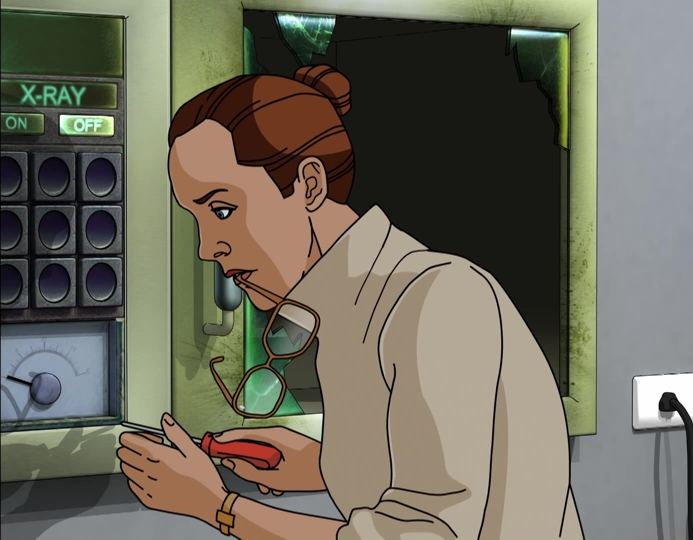

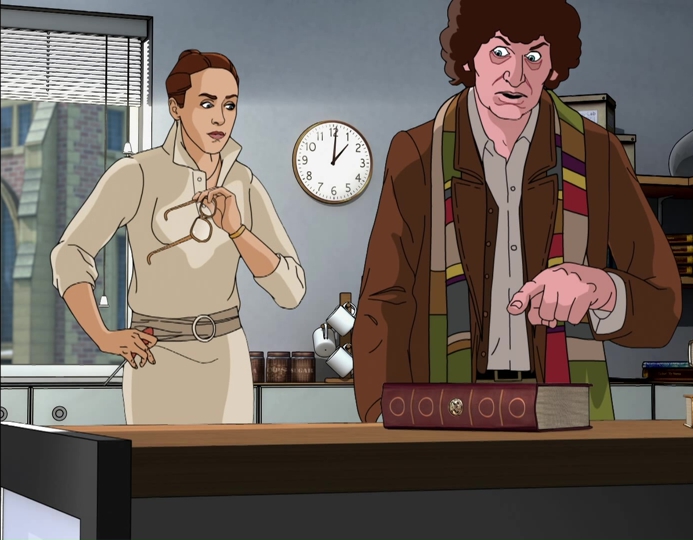
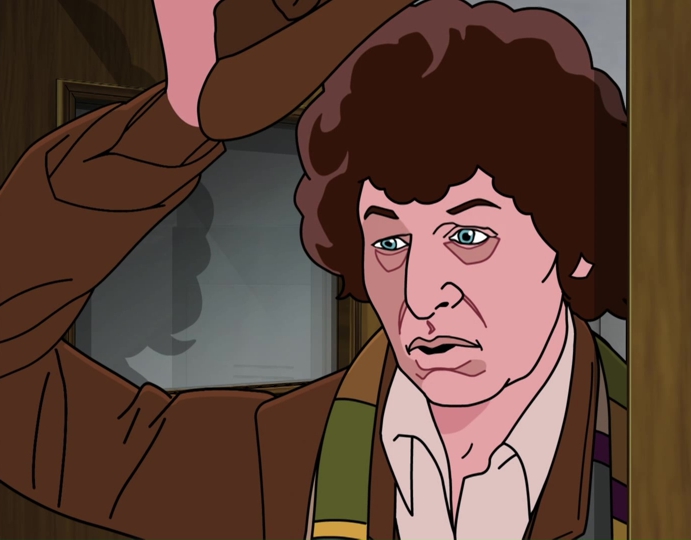
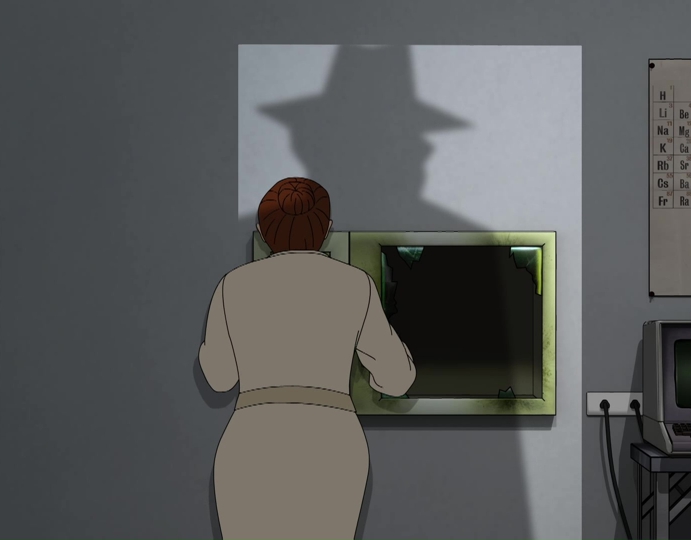
When this shot was originally animated, the sleeve of the Doctor's coat was drawn tight around the wrist, as if it were a shirt cuff. Of course, it's meant to be an overcoat and so the sleeve should hang under the wrist with the weight of gravity. It was a small error that we spotted early on. However, as it was such an incredibly minor niggle, we didn't immediately fix it. We simply added it to our list of 'things to fix if we have time'. It was not until the very end of production, just two days before delivery, that we finally had a chance to sit down with that list of 'things to fix if we have time'. And by that point, things were getting quite close to the wire. Still, the sleeve was a small thing and so we decided that it would be one of the things that we would try and fix. With so very little time left, Adrian Salmon stayed up and worked on it through the night, drawing on a new sleeve (over the top of the finished footage). He went through frame by frame and drew it in over the top of each frame. The following day, at Television Centre, we dropped this small animation patch on in Adobe Premiere and rendered off a new master. With minutes to spare, we'd just managed to squeeze in the very last fix. I walked out of the edit suite to tell Fiona Ball (Head of Production at BBC Studios) that we had a final revised master for her to send off for QC and mastering. Only for her to tell me that it was too late. They'd already sent the master off as it was. We'd cut it just that tiny bit too fine and the window had closed. So, I'm afraid that those watching the DVD and Blu-ray release a few months later had to make do with Tom Baker's uncorrected sleeve on this one shot, with Adrian's sleepless night bent over a graphics tablet seemingly having been all in vain.
I did at least have enough time to make sure that the corrected master was the one that got screened by the BFI at the National Film Theatre a few weeks later. And I also made sure that our final revised master was used as the basis for the BBC America television broadcast that went out in 2018. However, the original physical media releases all went out uncorrected. Of course, hopefully by the time you read this, you'll be enjoying the newly remastered 2021 box-set re-issue of Shada, which also uses the final corrected version of the shot. Giving many viewers their first opportunity to see Tom's dangling sleeve in all its glory.
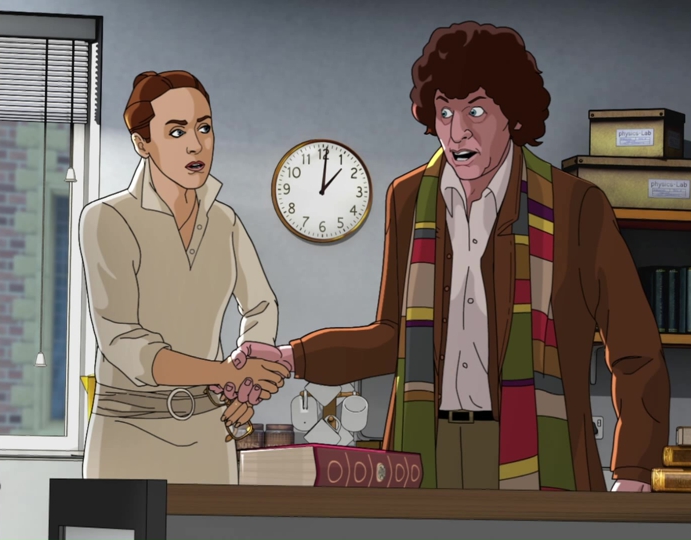
Another script cut here. The original 1979 scripts had another scene at this point (in between the end of that last lab scene and the start of the next study scene) that we ended up never actually recording. The scene was definitely one that Pennant Roberts intended to shoot, probably on 19th November 1979, as part of the second studio block at Television Centre. The 1980 four-part scripts indicate that it was later decided to heavily truncate the scene. However, even in that version of the script, some vestige of the scene remains. In 2017, we decided not to attempt the scene at all. Not because it's a terrible scene, although it's true that it isn't an essential scene and it doesn't affect the narrative to miss it out. However, that's not the main reason for us cutting it.
The main issue was actually a casting problem. The scene was originally planned to feature quite a bit of dialogue from K9, voiced by David Brierley. However, David died in 2008, so there was no way we could now (in 2017) complete the scene without either re-writing it or re-casting it. Both of which were things I was very keen to avoid. The scene was therefore simply skipped over.
What did you miss out on in the scene? Well, Romana comes into the TARDIS console room and calls K9 over to her. She tells him to sniff a pint of milk for her and tell her if it's fresh. K9 says it is. They then both leave the room. That's it really. I'm sure people will tell me that it's an absolutely vital component of Adams' narrative vision and that I've committed some grave sin in cutting it. That it totally distorts the entire meaning of the programme, but it really doesn't. It's also worth saying that the story is already over running a bit by this point anyway, only by a few minutes, but we are over. If they had shot everything as scripted in the 1979 script or everything as scripted in the 1980 script, then this is around the point where they'd have had to have started to make some cuts to bring the runtime down to fit their broadcast slot. And we had a similar concern too.
We were heading for a feature-length broadcast slot and a feature-length cinema release, so our margins were different. However, we were also running longer than projected at this point in the story. And when you reach that point, you have to start looking at scenes that are maybe not narratively vital and think about which of them you maybe can trim without damaging the rest of the narrative around them.
• MARK AYRES:
Having myself recently re-cut Shada into 6-parts, I can say with some level of certainty that the milk scene would have hit the cutting room floor in 1979. We are running long, here.
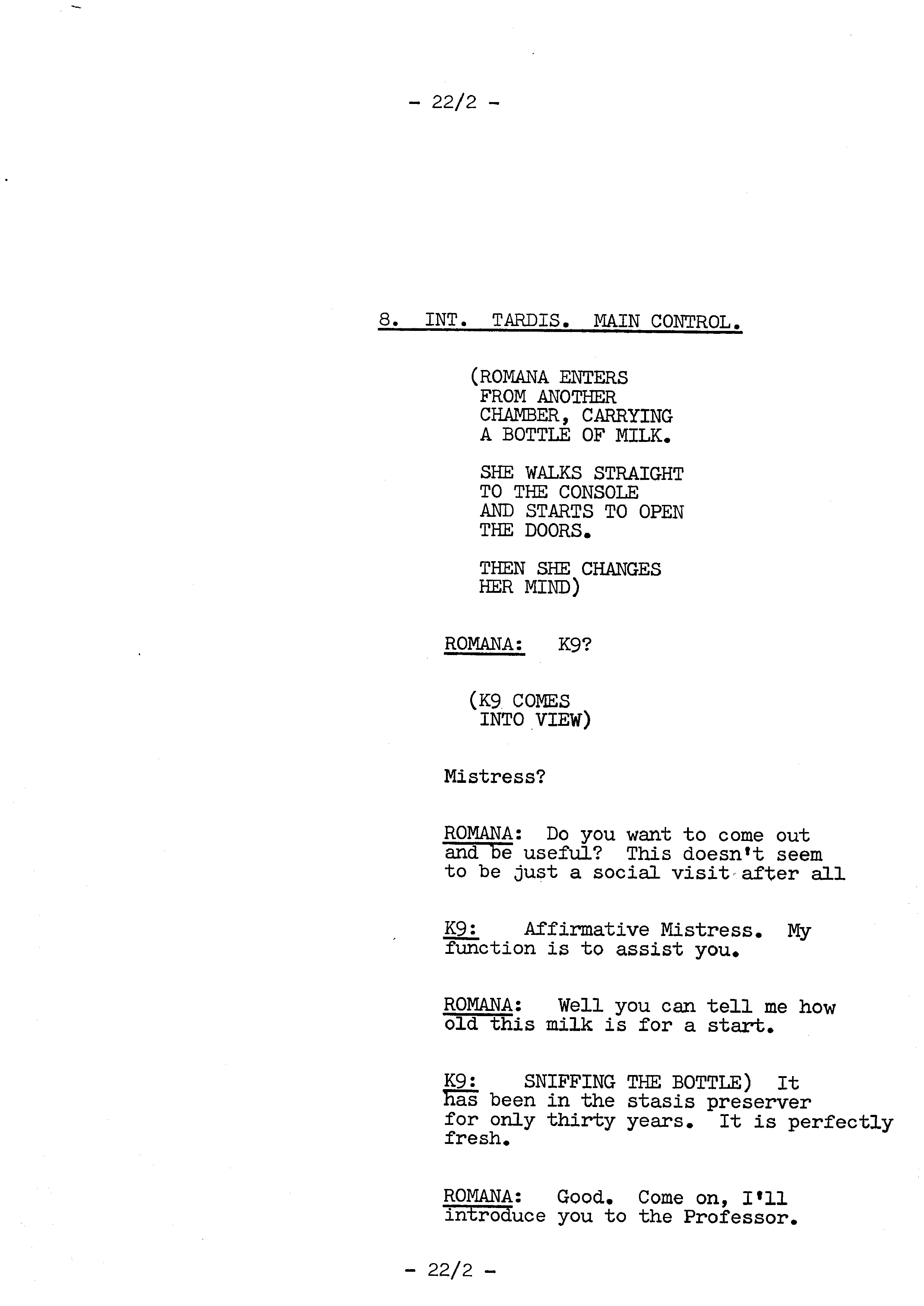
The computer bank you can see behind Clare here is actually a reworked bit of artwork originally created for the animation of The Power of the Daleks back in 2016. It's based on a real prop that popped up regularly in a number of 60s and 70s sci-fi shows. We simply lifted the artwork from one of the Power of the Daleks background plates and composited it in here. Incidentally, the whole of this scene (with character animation from Linda Kalcov) was cut from the edit shown on BBC America in 2018.
